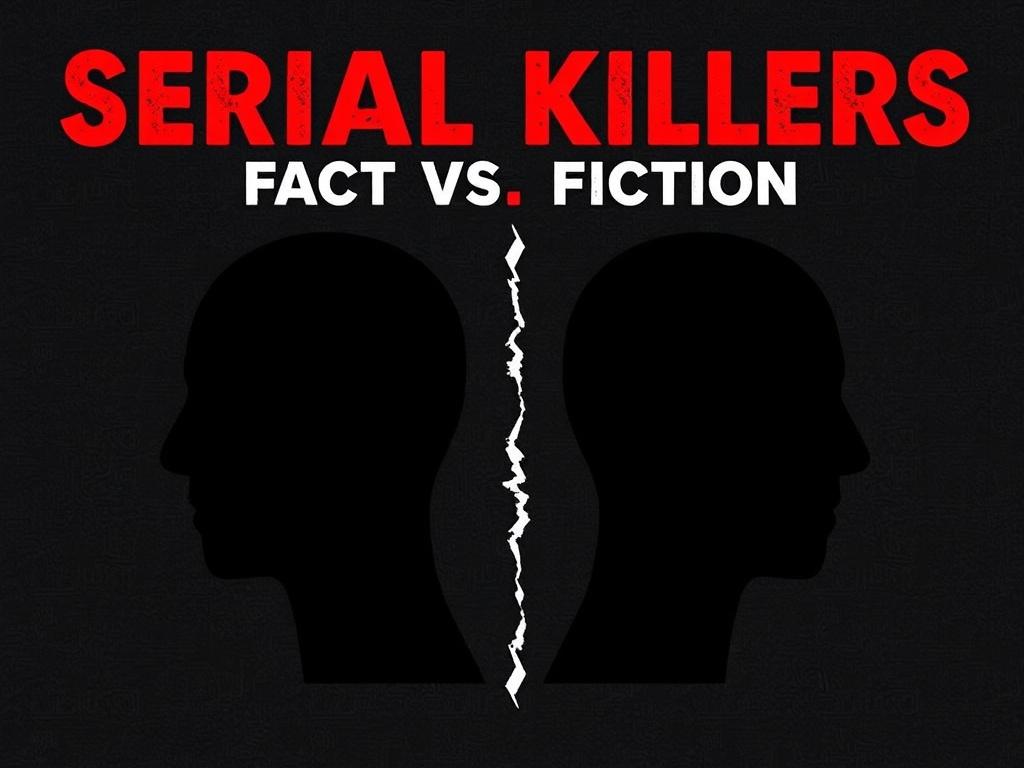When it comes to understanding serial killers, society has long been fascinated by the chilling stories that surround these elusive criminals. Whether portrayed in movies, TV shows, or books, the image of a serial killer and how they are profiled often sparks a mix of fear and curiosity. But how much of what we see in popular culture rings true, and how much is sensationalized fiction? Profiling serial killers is a complex process that often gets misunderstood, resulting in myths overshadowing reality. In this article, we’ll dive deep into the intriguing world of criminal profiling, uncovering the truth about how profilers work, what the real science behind it is, and how it compares to the fictional portrayals many of us have come to know.
Understanding What Serial Killer Profiling Actually Is

The term “profiling serial killers” often conjures images of dramatic moments where a profiler suddenly cracks a case by pinpointing the killer’s personality or background simply by analyzing crime scene evidence. In reality, criminal profiling is a much more systematic and evidence-based process. Profilers use a combination of crime scene data, behavioral patterns, victimology, and psychological theories to construct a profile of a likely suspect. This profile is not a definitive identification but rather a set of educated guesses intended to narrow down suspects and understand the motivations and behaviors of the killer.
Profiling serial killers involves several steps, including:
- Crime scene analysis
- Understanding the victim’s characteristics and lifestyle
- Reviewing patterns in offender behavior
- Developing a psychological and demographic sketch
- Assisting law enforcement in prioritizing suspects
It’s important to remember that profiling is just one tool among many in criminal investigations. It helps guide investigators rather than replace traditional detective work.
Common Myths About Profiling Serial Killers
The gap between fact and fiction in the world of profiling serial killers is especially wide because of the influence of media. Here are some of the most widespread myths and the reality behind them:
Myth 1: Profilers Have Psychic-Like Intuition
In TV shows, profilers often appear as almost supernatural characters, making leaps of insight that others cannot. In real life, profiling leans heavily on science and data, not mystical powers. Profilers analyze evidence and behavior actual behavioral science rather than “gut feelings.”
Myth 2: Profiling Can Identify a Killer Exactly
Many people think a profile can point to one person with 100% certainty. However, profiles are broad and probabilistic. They suggest likely characteristics, such as age range, occupation type, or psychological traits, but don’t provide a direct ID.
Myth 3: All Serial Killers Fit a Single “Type” or Template
One size does not fit all. Serial killers are diverse in their motives, backgrounds, and methods. Profiling seeks patterns but also understands the need to remain flexible and recognize the uniqueness of each case.
Myth 4: Profiling Is Always Accurate and Leads to Arrests
While profiling can be invaluable, it’s not infallible. Several cases have shown inaccurate profiles or leads that failed to produce results. Profiling is an aid, not a magic bullet for law enforcement.
The History of Profiling Serial Killers: From Early Beginnings to Modern Techniques
Profiling serial killers didn’t become a recognized practice until the latter half of the 20th century. The modern form of criminal profiling grew largely from the work of the FBI’s Behavioral Science Unit in the 1970s and 1980s.
The FBI’s Behavioral Science Unit
The FBI’s team began studying homicidal behaviors in detail, interviewing incarcerated serial killers and analyzing unsolved crimes. This research led to the development of the organized vs. disorganized offender typology—classifying killers based on their crime scene behaviors and psychological traits. Early profilers, such as John Douglas and Robert Ressler, are often credited with pioneering profiling serial killers as an investigative tool.
Key Milestones in Profiling Development
| Year | Event | Significance |
|---|---|---|
| 1940s-50s | Psychological assessments of offenders | Foundation for behavioral analysis |
| 1970 | Creation of FBI Behavioral Science Unit | Systematic study of serial killers begins |
| 1980s | Publication of profiling case studies | Profiling gains mainstream recognition |
| 1990s-2000s | Expansion to geographic and investigative psychology | More nuanced methods emerge |
How Profilers Actually Assess Serial Killers

The profiling process is a blend of art and science. It requires understanding both the behaviors that the serial killer reveals through their crimes and the psychological reasons behind those behaviors.
Step 1: Crime Scene Analysis
Crime scenes are more than just places where a crime happened; they tell a story. Profilers look at the location, the nature of the violence, evidence left behind, and how victims are treated to infer clues about the offender’s personality, skill level, and possible motives.
Step 2: Victimology
Understanding who the victims are—age, gender, lifestyle, and why they might have been targeted—helps profilers understand the killer’s preferences and personality. For example, consistent victim types might suggest a particular motive or psychological issue.
Step 3: Behavioral Patterns
Serial killers often display repeated behaviors or rituals in their crimes. Profilers analyze these patterns to classify the offender, such as whether they are organized or disorganized, whether they have a specific modus operandi, or whether there is a signature behavior that reveals deeper psychological needs.
Step 4: Psychological and Demographic Profiling
Using information collected, profilers attempt to provide insights about the offender’s probable age range, employment status, social habits, and mental health. This part of profiling overlaps with forensic psychology and often helps law enforcement identify suspects.
The Role of Technology and Data in Modern Serial Killer Profiling
While early profiling relied heavily on human intuition and interviews, the rise of technology and big data has transformed the field. Today, profilers use databases of crime scene evidence, offender behavior, and psychological profiles accumulated over decades.
Artificial Intelligence and Predictive Analytics
Law enforcement agencies increasingly explore AI to detect patterns that human profilers might miss. Machine learning algorithms examine large volumes of data, linking cases or predicting offender behavior based on previous crimes.
DNA and Forensic Advances
DNA profiling and forensic science have revolutionized criminal investigations. While profiling gives a behavioral and psychological sketch, forensic evidence often provides the conclusive link to suspects.
Geographic Profiling
Another technology-driven aspect involves analyzing the locations of crimes to predict where a serial killer might live or operate. Geographic profiling helps narrow down search areas based on spatial behavior patterns.
Popular Culture vs. Real-Life Profiling

Movies, TV shows, and novels have popularized the idea of criminal profiling—the “serial killer profiler” has become a beloved archetype. Shows like *Criminal Minds* and movies like *Silence of the Lambs* dramatize profiling for entertainment, often sacrificing accuracy for suspense.
How TV and Movies Get It Wrong
- Instant insights: Real profiling takes weeks or months.
- Psychic-like accuracy: Profiling is probabilistic, not definitive.
- Profiles alone catch killers: Real cases succeed through combined investigative efforts.
- Focus on one profile: Multiple possible offenders may fit a profile.
How Media Shapes Public Perception
The glamorization of profiling can lead the public to develop unrealistic expectations during actual criminal investigations. This can put pressure on law enforcement and create misconceptions about how investigations unfold.
Key Serial Killer Profiles and What They Show Us
Over decades, profiling has revealed common characteristics that often show up among serial killers, although no formula fits all. Here are some examples:
| Profile Trait | Explanation | Real-World Examples |
|---|---|---|
| Organized Offender | Planned crimes, controlled behavior, evidence cleaned up | Ted Bundy, John Wayne Gacy |
| Disorganized Offender | Impulsive, chaotic crime scenes, little planning | Edmund Kemper (early crimes) |
| Socially Isolated | Lonely or marginalized individuals, difficulty forming relationships | Gary Ridgway (Green River Killer) |
| Psychopathic Traits | Lack of empathy, manipulative, superficial charm | Jeffrey Dahmer, Richard Ramirez |
The Ethical Concerns and Limitations of Serial Killer Profiling
Despite its potential benefits, profiling serial killers raises important ethical questions. Profilers must avoid bias so that innocent people are not unjustly suspected or targeted. Over-reliance on profiling can undermine traditional investigative methods and may lead to tunnel vision.
Furthermore, profiling involves assumptions about behavior and psychology, which can sometimes stereotype groups or reinforce social prejudices unintentionally. For that reason, profilers operate within strict professional guidelines and are continuously trained to maintain ethical standards.
How Law Enforcement Uses Serial Killer Profiling Today
Profiling is just one part of the toolkit for law enforcement. It is often combined with forensic evidence, traditional detective work, witness interviews, and technology-driven analysis.
Profiling may help prioritize suspects, generate interview strategies, and understand offender motivations to anticipate future actions. Although it doesn’t solve crimes on its own, many investigators report that profiling helps them see cases from a fresh perspective.
Future Directions in Serial Killer Profiling
The science of profiling is evolving rapidly. As artificial intelligence advances and more data becomes available, profiling techniques are likely to become more accurate and nuanced. Collaboration between psychologists, data scientists, and law enforcement is growing to make profiling less subjective and more evidence-based.
Research into brain imaging, genetics, and criminal psychology could also offer deeper understanding of serial killer behavior, perhaps allowing early intervention or more effective prevention in the future.
Summary Table: Fact vs. Fiction in Profiling Serial Killers
| Aspect | Fiction | Fact |
|---|---|---|
| Profiling Accuracy | Profiles give exact killer identity | Profiles suggest possible traits and narrow suspects |
| Timeframe | Instant conclusions in hours or days | Often takes weeks or months to build a profile |
| Role in Investigation | Profiles lead directly to arrests | Profiling supports other investigative methods |
| Profiler’s Abilities | Supernatural insight or psychic powers | Methodical analysis based on behavioral science |
| Killer Types | One general “serial killer” type | Multiple types with diverse backgrounds and motives |
Conclusion
Profiling serial killers is a fascinating but often misunderstood field that blends psychology, criminology, and investigative science. While Hollywood and popular media paint a dramatic picture of profilers magically uncovering villains, the real work is far more detailed, methodical, and reliant on evidence. Understanding the facts behind the fiction helps us appreciate profiling as a valuable tool—not an infallible magic trick—in the fight against some of the most chilling criminals. By recognizing both its strengths and its limitations, society can better grasp how law enforcement approaches these difficult cases and how profiling continues to evolve alongside advances in science and technology.




















